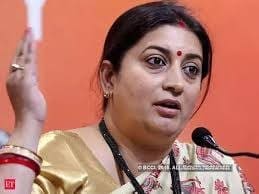Union Minister of Textiles, Smriti Zubin Irani said that India needs to reposition handloom sector and look at the larger consumption market.
Dr. APJ Abdul Kalam Centre for Policy Research & Analysis under the aegis of IIM Shillong today hosted an e-symposium on Handloom Sector, Irani said “For far too long, I think the handloom legacy of our country has been romanticised with the element of poverty, and I think from the marketing perspective we need to reposition ourselves and look at the larger consumption market”
She said, “ Today when sustainability has become the buzzword not only for manufacturers, buying agents, and international chains that can leverage the handloom opportunity, there has to be a more systemic approach on how to make handlooms a better business opportunity given the semblance of pride in the handloom legacy of our country, particularly the northeast, while also trying to understand the issues that ail this particular sector that we are today talking about. Some of the points brought forward by her for consideration was the necessity to encourage weavers to actually have a business plan and a pathway to success, which means looking at input costs, access to better credit, access to better design opportunities, understanding of IPR and packaging, which also entails how positioning and branding of raw material can differ from one segment to the other. “
She further added, “Instead of looking at a minute segment which we see to service, we need to look at a product range for a larger consumer base,” while emphasising on not looking only at exports but also servicing India which is one of the largest global consuming markets of the world”.
The minister reiterated the need for youngsters to retain the craft through use of available design technology so as to reduce the challenge that the weaving community has in terms of current feeling of limited opportunities amongst youngsters, and the need for sustaining the handloom sector. “The government at the ministry level is encouraging a lot of people to come together as producer companies,” she said, while also highlighting one of the major challenges of people positioning themselves as master craftsperson, who are not necessarily producers but only serve as a go-between, between the market and the actual weaver.”
The minister added, “How can we break that system and encourage the individual weaver or set of weavers to come together and form producer companies,” she further pointed out while enlightening on government initiatives towards credit facilities such as Mudra Yojana where according to studies done, she said post access to the scheme a weaver’s income increases by at least 50 to 60 percent, “which means we need more and more research which can build credibility to such outreach programs,” she added.
Chairman of the Board of Governors, IIM Shillong Shishir Bajoria said “Since the pandemic has impacted the world economy has taken a backseat. Lots of workers from the northeast who were earning their livelihoods from the different parts of the country have returned home. In this situation handloom sector can be primed up to boost the economy of the entire region and generate employment. What it needs is requisite intervention in terms of finance, appropriate technological introduction, creation of brand identities, forward and backward integrations, and above all logistics support.”

